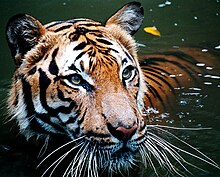Zoo Negara is home to 5137 animals of 459 different species. Over the years, the zoo has transformed itself to an open concept zoo with over 90% of its animals kept in spacious exhibits with landscape befitting its nature.
Zoo Negara received MS ISO 9001:2008 certification in July 2007, and is a member of the South East Asian Zoos Association (SEAZA). The President and chairman of the zoo is Y. Bhg. Dato’ Ismail Hutson.
In 1957, the Malayan Agri-Horticultural Association (MAHA) opened a miniature zoo. After the creation of the mini-zoo, the idea of proper zoo gradually gained momentum, and the federal government chose a spot in Ulu Klang, Selangor next to the border of Kuala Lumpur. In the 1960s, Ulu Klang was an undeveloped green area. In 1963, the first Prime Minister of Malaya (now Malaysia) YTM Tunku Abdul Rahman opened the zoo to the public. Zoo Negara was known as the "Zoo in the Jungle" due to the greenery that surrounded the area.
The zoo welcomed its millionth visitor on February 14, 1966, just three years after opening, and by 1986, the zoo was welcoming over 1 million visitors per year.[1]
The area surrounding the zoo was covered with thick vegetation until the late 1970s as Kuala Lumpur underwent an economic boom. Given Ulu Klang's close proximity with Kuala Lumpur, the area was opened for large scale development as a planned residential area in the 1980s. It has expanded in terms of population ever since. The development has caused the zoo's surrounding areas and also increases the land value where the zoo is located.
In the late 1990s and early 2000s, there were plans to move the zoo to other locations in Selangor. However, the plans were largely unpopular among the public as it is seen as an effort by some developers to capitalise on the value of the zoo's large land. With the support from the Ministry of Natural Resources and Environment and the Selangor State Government, Zoo Negara will not be relocated.
- Reptile Park
The Amphibian World center at the Reptile Park has a variety of frogs and toads that originate from various habitats in Malaysia.
- Monkey/Lesser Apes
- Malaysian Elephants
- Malaysian Elephants
- Lake Birds
- Bird Aviary
- Cat Walk


- Ape Centre


- Other Animals
 Barasingha
Barasingha Wild boar

[edit] Other attractions
Sea Lions, macaques and macaws are part of a Multi-Animal Show that is shown twice daily.
Train rides and guided tours are available on weekends.
The Mini Bee Museum is located at the heart of Zoo Negara and helps educate visitors about the many types of bees in the country.
The Multi-Animal Photo Corner is located by the zoo's main entrance, and is opens on weekends. Visitors can have their pictures taken with snakes, miniature horses and birds

Address:
Zoo Negara Malaysia
Jalan Ulu Kelang
68000 Ampang
Selangor Darul Ehsan
Tel: +60 3 4108 3422
Fax: +60 3 4107 5375 Adults: RM15.-
Children: RM 10,-

Address:
Zoo Negara Malaysia
Jalan Ulu Kelang
68000 Ampang
Selangor Darul Ehsan
Tel: +60 3 4108 3422
Fax: +60 3 4107 5375Adults: RM15.-
Children: RM 10,-





